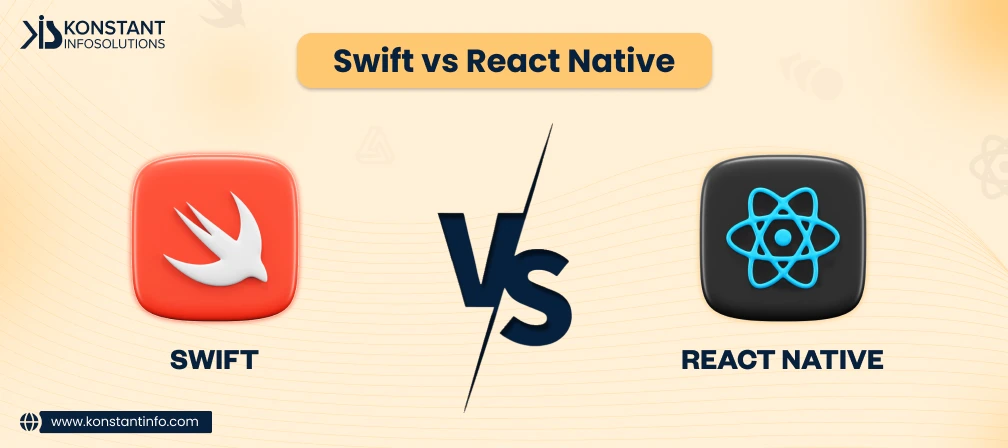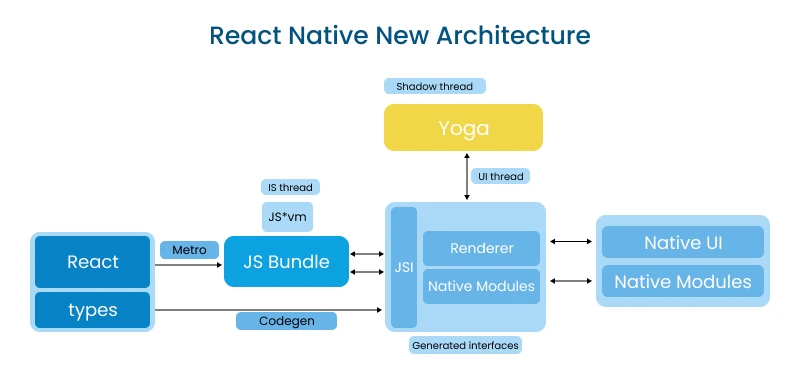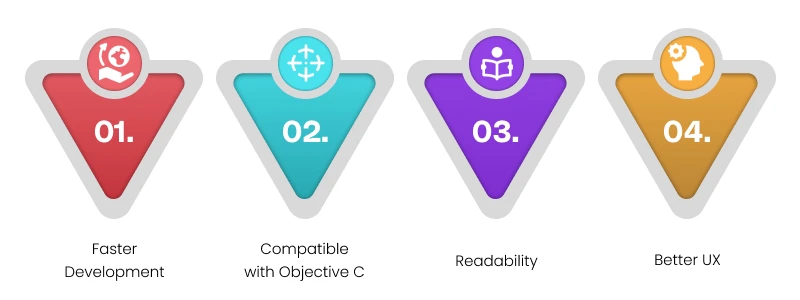
However, there are a lot of other differences between Swift vs React Native that need to be considered before you choose one for your project.
If you are someone wondering what to choose for your next mobile app development project among Swift vs React Native in 2025, then this write up is here to guide you. For instance, Swift has better UI/UX components within the framework while React Native utilizes APIs. We will cover a brief definition, pros, cons, and top differences between React Native vs Swift.
React Native is a JavaScript based framework for iOS and Android mobile application development released by Facebook in 2015. The goal of the React Native framework was to expedite the mobile development process and create cross-platform mobile applications. The app is used to build apps like Wix, Walmart, and Bloomberg.
JavaScript, which is used by React Native, is more beneficial than Swift and is the most widely used language worldwide. Up to 70% of the code can be shared between platforms by developers thanks to JavaScript’s code reusability capability. This will consequently save you money and development time when creating cross-platform apps. The React native app development companies can build code for both the iOS and Android platforms.

React Native is an operating system independent, which dramatically shortens the development cycle and time to market. This is accomplished by writing a single code and deploying it to both platforms with a few native changes. Apart from this, React utilizes JavaScript and facilitates code reusability that allows it to reuse 90% of the code and save developer’s time & efficiency. The framework takes between one and five months to build an app which is 33% faster than the iOS programming language, Swift.
Building a single program for iOS and Android allows you to have one JavaScript team on staff rather than two native development teams. You will also eliminate timeline mismatches, which are common when two teams are developing two applications simultaneously. Finally, having a single team execute all of the work eliminates problems that arise when one of the developers falls ill, as his or her peers can simply pick up the slack.
Hot Reloading allows React Native Developers to observe the latest updates and changes in the application development process in real time without restarting it. The feature is small but really important to speed up the whole mobile app development process.
React Native’s modular architecture isolates various program functions into flexible modules. This increases flexibility, improves cooperation, and allows for seamless upgrades. It makes it easy for a React native app development company to deploy app updates and encourages module reuse, similar to web APIs. This increases efficiency while also allowing for code reuse.

In terms of performance and speed, cross-platform solutions consistently fall short of native apps. React Native applications take up more space on the device and, on average, provide a worse user experience for your customers. However, this issue only becomes relevant when discussing high-dynamic products, such as games.
Although designing applications with React Native is faster since it uses a single code source, testing takes longer when compared to Swift. React Native apps necessitate greater effort and precision while conducting tests, as faults are likely to occur on both platforms.
Swift is a programming language based on Apple technology. Swift was designed in 2014 to replace Apple’s prior programming language. The programming language was called Objective-C. Swift is popular among iOS app development companies because it is an intuitive language that aligns with Apple’s overall philosophy. The programming language is used to build many robust mobile apps like Lyft, Airbnb, and Twitter.
There is a handy ARC (automatic reference counting) tool for working with RAM. Surprisingly, this language lacks a single “progenitor”. Instead, Swift’s designers borrowed from a variety of languages, including Object-C, Haskell, Python, C#, CLU, and more.

Swift was released by Apple over its predecessor, Objective C, and claimed it to be 2.6 times faster. Further, the language has a clear and compact syntax and compiles the code directly to the machine code using its LLVM tool that facilitates faster development process for a Swift app development company.
Apart from this, the Automatic Reference Counting feature efficiently handles the memory usage, guaranteeing a seamless performance.
Existing Objective C codebases can easily integrate with Swift and work smoothly. This facilitates app development companies to leverage Objective C’s efficient features along with new functionalities in Swift.
Swift has a clear language style and compact syntax making it easy to learn for developers. The language is more readable than others and needs lesser coding lines to develop mobile apps, thus reducing the time to market duration.
Swift is a light programming language and thus it takes less storage on the device and takes less time to install. Further, the language has access to native features and was especially developed for native iOS mobile app development. As a result, users can develop applications that perform and look better, attracting more & more users.
The Swift open-source community may not be as vast as others right now, which could mean fewer experienced developers and resources available for novices in need of assistance. Nonetheless, it’s always expanding.
Swift’s inability to enable backward compatibility causes several complications. This is because projects completed in previous versions may not transition cleanly to current ones. Despite this, Swift has attempted to address this issue head-on, particularly with the fifth version release.
| Aspect | Swift | React Native |
|---|---|---|
| Developed by | Apple | |
| Release Year | 2014 | 2015 |
| Market Share | Less Popular | More Popular |
| Application Architecture | iOS-specific | Cross-platform (iOS, Android) |
| Type | General-purpose programming language | Open-source JavaScript-based Framework |
| Learning Curve | Steeper | Smooth |
| Developer’s Availability | Lower | Higher |
| Performance | Excellent | Native-Like |
| User Interface | iOS native UIs using SwiftUI | Native components wrapped using APIs |
| Stability | More Stable | Less Stable |
| Speed of Coding | For iOS, Swift can provide faster Development | Faster development for both platforms |
| Platform Maturity | Relatively new | Leverages all the legacy of JavaScript |
| Community Support | Relatively Smaller Community | Established & Larger Community |
| Documentation | Apple offers great documentation support. | Excellent, benefit of automated documentation. |
| Development Cost | High | Relatively Low |
| CPU Consumption | Efficient | In-efficient |
| GPU Speed | In-efficient | Efficient |
| Memory Usage | In-efficient | Highly Efficient |
| Development Time | Slow | Fast |
| Size of Development | Light | Heavy |
| OTA Updates | Not Supportable | Supportable |
| Maintenance | Easy | Difficult |
| Supporting Platforms | Apple OS | Windows, iOS, Android |
| Syntax | Truly Expressive Syntax | JSX Syntax |
React Native relies on JavaScript for coding, but Swift has its own programming language.
JavaScript is extremely popular among web developers, with a large community supporting it. Front-end developers can easily learn React Native by transferring their JavaScript experience. Swift has a tiny but quickly expanding community. It continues to gain popularity, particularly among iOS app development companies.
Swift draws cues from other languages such as Python and Objective-C. The syntax is concise, with few difficult notions, making it very straightforward to learn, even for beginners.
Result – JavaScript is better known, but Swift is a more current programming language designed specifically for Apple devices. Both languages have their advantages; hence this aspect is a tie.
| Aspect | Swift | React Native | Winner |
|---|---|---|---|
| Primary Programming Language | Swift | JavaScript | Tie |
Both platforms provide good help in the form of tutorials, guidelines, Stack Overflow queries, and an active developer community. React Native now has a larger community than Swift since JavaScript is more commonly utilized around the world.
There are plenty of third-party libraries and mobile app development tools for Swift and React Native. Apple develops and maintains Swift, thus Xcode and SwiftUI have excellent tooling. React Native has a strong ecosystem built by its community.
Result – Overall, both have great documentation and vibrant communities surrounding them. JavaScript’s worldwide dominance gives React Native a slight advantage here.
| Aspect | Swift | React Native | Winner |
|---|---|---|---|
| Documentation | Good | Better than Swift | React Native |
Native Swift apps execute quicker and more smoothly. Swift has complete access to the device’s hardware and operating system. This enables apps to attain 60 frames per second performance even with complicated user interfaces.
For the majority of use scenarios, React Native performs similarly to native applications. However, apps may experience stuttering or lag on occasion, particularly on lower-end smartphones. React Native communicates with native code via a JavaScript bridge.
Result – In terms of performance, Swift is a clear winner over React Native as it supports a high end GUI to improve the overall performance.
| Aspect | Swift | React Native | Winner |
|---|---|---|---|
| CPU Consumption | Efficient | In-efficient | Swift |
| GPU Speed | In-efficient | Efficient | |
| Memory Usage | In-efficient | Highly Efficient |
React Native makes learning reasonably simple. However, developers transitioning from web to app development may require time to adapt.
Swift provides comprehensive guides and resources, such as Swift Playgrounds, to assist developers of all skill levels learn more effectively.
Result – Overall, React Native is easier to learn than Swift due to the former’s attachment to JavaScript.
| Aspect | Swift | React Native | Winner |
|---|---|---|---|
| Learning Curve | Steeper | Smooth | React Native |
Both Swift and React Native may be used to create visually appealing apps with dynamic user interfaces. Both allow for smooth animations, motions, transitions, and scrolling at 60 frames per second.
React Native offers an adaptable UI framework. Complex UIs are created by nesting various components in a declarative manner. SwiftUI offers a comparable declarative UI creation approach in Swift. These current mobile app frameworks enable quick UI creation without manually laying out each view.
Result – In terms of UX capabilities, Swift and React Native perform admirably. The experience will ultimately depend on the designer’s abilities rather than the platform itself.
| Aspect | Swift | React Native | Winner |
|---|---|---|---|
| UI/UX | Swift UI | Native Components Wrapped | Tie |
Swift is noted for its steadiness. It handles difficult tasks and visual effects efficiently, making it a reliable choice for iOS programming.
React Native, recognized for its cross-platform framework that works on several platforms, primarily intends to use its internal APIs and libraries. This can occasionally add layers to the development process and impact stability.
Result – Overall, in terms of Stability and steadiness, Swift takes the lead.
| Aspect | Swift | React Native | Winner |
|---|---|---|---|
| Stability | More Stable | Less Stable | Swift |
React Native allows for speedier development as it allows code reusability, a large library of open-source components, and rapid reloading. Hot reloading applies your changes immediately without recompiling the app.
While Xcode offers live previews, Swift’s build times can impede development. SwiftUI’s declarative syntax improves UI code productivity.
Result – Overall, React Native makes mobile programming easier, allowing you to accomplish more with less code. A smaller React native team can work faster than native iOS and Android teams.
| Aspect | Swift | React Native | Winner |
|---|---|---|---|
| Coding Speed | Slow | Fast | React Native |
One significant advantage of React Native is code reuse. When creating code for both iOS and Android, you may reuse approximately 90% of it. Components and business logic should only be developed once in JavaScript. This considerably accelerates development and decreases expenses when compared to implementing native apps independently.
Swift requires you to build iOS and Android apps directly in their respective codebases. While SwiftUI and other frameworks reuse UI code, the majority of business logic and native modules must be rebuilt for each platform.
Result – In terms of code reusability, React Native is the clear winner. You receive two apps for the price of one.
| Aspect | Swift | React Native | Winner |
|---|---|---|---|
| Code Reusability | Limited | Better than Swift | React Native |
Cost plays a major role for everyone who wants to choose a technology for their next project. Apart from technology, cost is determined by several other factors including the chosen app development company.
React Native has an advantage in the cost due to code reusability feature. It allows developers to build apps for both iOS and Android in a single code.
In comparison, Swift requires additional resources, efforts, and time for Android app development, thereby increasing the overall mobile app development services cost.
Result – Thus, React Native is a clear winner in development cost.
| Regions | Swift | React Native | Winner |
|---|---|---|---|
| USA | $80-$300+ | $70-$200+ | React Native |
| Western Europe | $60-$200+ | $60-$150+ | |
| Eastern Europe | $50-$150+ | $50-$120+ | |
| Asia | $25-70+ | $25-$60+ |
React Native’s bridge modules provide access to a variety of native device functionalities, including camera and geolocation. However, certain highly specialized native capabilities may not currently be offered through React Native.
Swift provides 100% direct native access to all iPhone and iPad capabilities since it produces native code. This comprises the most recent APIs that Apple releases each year.
Result – Swift dominates when it comes to direct native feature access on Apple devices. React Native is catching up in terms of supporting the most recent native APIs.
| Aspect | Swift | React Native | Winner |
|---|---|---|---|
| Access to Native Features | 100% Native Access | Limited | Swift |
Both React Native and Swift are younger technologies. React Native was launched in 2015, and Swift in 2014, thus they are both quite new. However, with each version update, we welcome the increased robustness.
Despite being a native app builder, React Native is not entirely native, unlike Swift, the iOS app development language. React Native serves as an intermediary between the code and the iOS platform. Swift produces outstanding performance when dealing with large computational and graphic workloads.
Result – Although both of them are still young but have worked on the tech extensively. So, both of them are winners here and thus, it is a tie.
| Aspect | Swift | React Native | Winner |
|---|---|---|---|
| Maturity | Young | Young | Tie |
React Native’s cross-platform features have gained popularity, particularly for its effectiveness in developing apps for both iOS and Android. Swift, Apple’s programming language, is dominating in iOS development, reflecting its exclusivity to Apple’s environment. Market shares might fluctuate, so the most up-to-date data is required for an accurate comparison.
As we all know, React Native is a JavaScript framework, so comparing React Native versus Swift entails comparing Swift to JavaScript.
Result – According to a recent Stack Overflow study, JavaScript is 63.61% popular among the global developer community, whereas Swift is 4.65%, making React Native a clear winner here.
| Aspect | Swift | React Native | Winner |
|---|---|---|---|
| Market Share | 63.61% | 4.65% | React Native |
Many talented mobile app development services providers throughout the world use React Native, an open-source programming language. React Native has a thriving community with global support from corporations and contributors including Microsoft, Infinite Red, 0Software Mansion, Expo, and Callstack.
When we compare React Native to Swift, Swift’s improvements are guaranteed because Apple, one of the world’s largest organizations, backs it. The Swift community is extremely supportive and dedicated to making Swift the finest programming language available.
Result – While the Swift and React Native communities are both robust, React Native has a minor advantage in terms of community support.
| Aspect | React Native | Swift | Winner | ||
| GitHub Stars | 113k | GitHub Stars | 64.6k | React Native | |
| GitHub Contributors | 2589 | GitHub Contributors | 1049 | ||
| Fork | 24.1K | Fork | 10K | ||
Both, Swift and React Native, are popular among developers and are used as per the project requirement. The decision to choose between RN and swift also depends upon the type of product you are building. Some mobile apps are built better on React Native while for others, Swift is a good choice. Below is a table of comparison about which technology to choose for which type of application –
| Type of Mobile Application | React Native | Swift |
|---|---|---|
| “Fetch and Display Data” Apps | ✓ | |
| Scalable Mobile App For iOS | ✓ | |
| Apps for Business Demanding High Level Of Security (Bank, Fintechs) | ✓ | |
| App For a Single Event or Conference | ✓ | |
| Single Platform App | ✓ | |
| Apps Demanding Native Platform APIs or Payment Systems | ✓ |
Both React Native and Swift widely use among developers to build high performing, robust mobile applications. Below are some of the most popular applications built on Swift and React Native –
| Popular Apps on Swift | Popular Apps on React Native | ||
|---|---|---|---|
|
|
|
|
So, this was the comparison between React Native vs Swift for mobile app development. Both of them have their strengths & weaknesses and thus, there is no clear winner among them.
Swift is an ideal choice for developing iOS focused app that requires top quality performance and robust graphics. The language offers an effective and personalized method for building iOS app, making it a good choice.
React Native on the other hand is a good choice for building cross platform applications for both iOS and Android OS. React native frameworks provide some exceptional features such as hot reloading & code reusability that boost the mobile app development process.
Thus, it is irrational to announce a winner among them. Both of them are growing technologies and one needs to choose as per their requirements.
At last, it is essential to consider your requirements, project needs, and several other factors. Some of the most common factors are budget, type of app, and project timeline. For instance, if you are aiming to build an iOS app with robust UI/UX and high performing features, then Swift is an ideal choice. Apart from this, the choice of mobile app Development Company plays a crucial role. The technical partner should have the required experience as per your project needs and the required tech resources.
Although Swift has great learning resources and system for beginners, React Native is based upon JavaScript, which is the most common programming language.
React Native comes with cross platform abilities and thus allows code reuse across operating systems. As a result, React Native is 33% faster (on average) than Swift for mobile app development.
Yes, it is possible to use Swift and React Native together in a project. Developers can call the react module and compile in Xcode. Overall, it is possible to open React native projects in Xcode.
No, both React Native and Swift come with their pros & cons and thus, both of them can co-exist. The framework choice depends upon the usage and the requirement of the project.
Swift and React Native both are excellent at their respective work and come with their own strength & weaknesses. The choice depends upon the individual requirement.
Developers looking to build cross platform apps can go with React Native. Similarly, if a developer is looking at iOS mobile app development, then Swift is a good choice.



Manish Jain is the co-founder and Managing Director at Konstant Infosolutions. He is responsible for the overall operations of the company and has played a major role in bringing Konstant up from its humble beginnings and, with his immense energy and drive, transforming it into a globally trusted name in IT solutions.
Or send us an email at: [email protected]